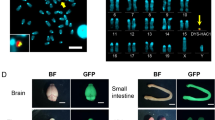Summary
The identification and cloning of the gene responsible for Duchenne muscular dystrophy (DMD) and characterization of the protein product of the gene, dystrophin, has led to major advances in diagnostic and genetic counselling procedures for this inherited disorder. Due to its high mutation rate, however, individuals affected by DMD will continue to arise in large proportion by de novo mutations, and the search for direct therapies remains a high priority. In this respect direct genetic correction of dystrophin deficiency via grafting of healthy myoblast stem cells or direct introduction of functional DNA into diseased muscle tissue have both been proposed as potential therapeutic approaches. We describe here, the first example of the engineering and cloning of a synthetic gene encoding recombinant human dystrophin and its stable transfer to and expression in mammalian cells. This DMD gene construction represents a primary step towards evaluating direct DNA-mediated gene transfer as a potential treatment for this debilitating disorder.
Similar content being viewed by others
References
Bulfield G, Siller WG, Wight PAL, Moore KJ (1984) X-Chromosome-linked muscular dystrophy in the mouse. Proc Natl Acad Sci USA 81:1189–1192
Cross GS, Speer A, Rosenthal A, Forrest SM, Smith TJ, Edwards Y, Flint T, Hill D, Davies KE (1987) Deletions of a muscle cDNA in Duchenne and Becker muscular dystrophy patients. EMBO J 6:3277–3283
Dickson G, Peck D, Moore SE, Barton CH, Walsh FS (1990) Enhanced myogenesis in NCAM-transfected mouse myoblasts. Nature 344:348–351
Dunne PW, Epstein HF (1991) Molecular biology of human muscle disease. Biotechnology 9:41–46
Emery AEH (1987) Duchenne muscular dystrophy. (Oxford monographs in medical genetics, no 15) Oxford Medical Publications, Oxford
England SB, Nicholson LVB, Johnson MA, Forrest SM, Love DR, Zubrzycka-Goarn EE, Bulman DE, Harris JB, Davies KE (1990) Very mild muscular dystrophy associated with deletion of 46% of dystrophin. Nature 343:180–182
Feener CA, Koenig M, Kunkel LM (1989) Alternative splicing of human dystrophin mRNA generates isoforms at the carboxy terminus. Nature 338:725–728
Felgner PL, Rhodes G (1991) Gene therapeutics. Nature 349:351–352
Fong P, Turner PR, Denetclaw WF, Steinhardt RA (1990) Increased activity of calcium leak channels in myotubes of Duchenne human and mdx mouse origin. Science 250:673–675
Forrest SM, Cross GS, Flint T, Speer A, Robson KJH, Davies KE (1988) Further studies of gene deletions that cause Duchenne and Becker muscular dystrophies. Genomics 2:109–114
Friedmann T (1989) Progress towards human gene therapy. Science 244:1275–1281
Hodgson SV, Bobrow M (1989) Carrier detection and pre-natal diagnosis in Duchenne and Becker muscular dystrophy. Br Med Bull 45:719–744
Hoffman EP, Kunkel LM (1989) Dystrophin abnormalities in Duchenne/Becker muscular dystrophy. Neuron 2:1019–1029
Karpati G (1991) The principles and practice of myoblast transfer. Adv Exp Med Biol 280:69–74
Koenig M, Monaco AP, Kunkel LM (1988) The complete sequence of dystrophin predicts a rod-shaped cytoskeletal protein. Cell 53:219–228
Koenig M, Beggs AH, Moyer M, Scherpf S, Heindrichs K, Bettecken T, Meng G, Muller CR, Lindolf M, Kaariainen H, Chapelle A de la, Kiuru A, Savontaus ML, Gilgenkrantz H, Recan D, Chelly J, Kaplan JC, Covone AE, Archidiacono N, Romeo G, Liechti-Gallati S, Schneider VC, Braga S, Moser H, Darras BT, Murphy P, Francke U, Chen JD, Morgan G, Denton M, Greeneberg CR, Wrogemann K, Blondon LAJ, Paassen HMB, Van Ommen GJB, Kunkel LM (1989) The molecular basis for Duchenne versus Becker muscular dystrophy: correlation of severity with type of deletion. Am J Hum Genet 45:498–506
Kunkel LM, Hoffman EP (1989) Duchenne/Becker muscular dystrophy: an overview of the gene, the protein and current diagnostics. Br Med Bull 45:630–643
Law PK, Bertolini TE, Goodwin TG, Chen M, Fang Q, Li HJ, Kirby D, Florendo JA, Herrod HG, Golden GS (1990) Dystrophin production induced by myoblast transfer therapy in Duchenne muscular dystrophy. Lancet 336:114–115
Lee CC, Pearlman JA, Chamberlain JS, Caskey CT (1991) Expression of recombinant dystrophin and its localization to the cell membrane. Nature 349:334–336
Lidov HGW, Byers TJ, Watkins SC, Kunkel LM (1991) Localization of dystrophin to postsynaptic regions of central nervous system cortical neurons. Nature 348:725–728
Menke A, Jockusch H (1991) Decreased osmotic stability of dystrophin — less muscle cells from the mdx mouse. Nature 349:69–71
Morgenstern JP, Land H (1990) A series of mammalian expression vectors and characterization of their expression of a reporter gene in stably and transient transfected cells. Nucleic Acids Res 18:1068
Nicholson LVB, Davison K, Falkous G, Harwood C, O'Donnell E, Slater C, Harris JB (1989) Dystrophin in skeletal muscle: Western blot analysis using a monoclonal antibody. J Neurol Sci 94:125–136
Ohlendieck K, Ervasti JM, Snook J, Campbell KP (1991) Dystrophin-glycoprotein complex is highly enriched in isolated skeletal muscle sarcolemma. J Biol Chem 112:135–148
Patridge TA, Morgan JE, Coulton GR, Hoffman EP, Kunkel LM (1989) Conversion of mdx myofibres from dystrophin-negative to -positive by injection of normal myoblasts. Nature 337:176–179
Sambrook J, Fritsch EF, Maniatis T (1989) Molecular cloning: A laboratory manual. Cold Spring Harbor Laboratory, Cold Spring Harbor, NY
Smith TJ, Wilson L, Kenwrick SJ, Forrest SM, Speer A, Coutelle C, Davies KE (1987) Isolation of a conserved sequence deleted in Duchenne muscular dystrophy patients. Nucleic Acids Res 15:2167–2174
Walsh FS, Ritter MA (1981) Surface antigen differentiation during myogenesis in culture. Nature 289:60–64
Wolff J, Malone RW, Williams P, Chong W, Ascadi G, Felgner PL (1990) Direct gene transfer into mouse muscle in vivo. Science 247:1465–1468
Zatz M, Lange K, Spencer MA (1977) Frequency of Duchenne muscular dystrophy carriers. Lancet I:759
Author information
Authors and Affiliations
Rights and permissions
About this article
Cite this article
Dickson, G., Love, D.R., Davies, K.E. et al. Human dystrophin gene transfer: production and expression of a functional recombinant DNA-based gene. Hum Genet 88, 53–58 (1991). https://doi.org/10.1007/BF00204929
Received:
Issue Date:
DOI: https://doi.org/10.1007/BF00204929




